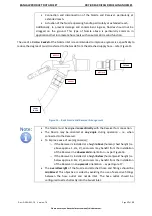
BANLAW PRODUCT DATA SHEET
DRY-BREAK DIESEL REFUELLING NOZZLES
Doc ID: PRH-REF-70 Version: 7.0
Page
3
of
32
Please ensure you have the latest version of this document.
1.1
Glossary of Terms
The following glossary defines key terms used within this document.
Dry-Break
An industry term used to describe a fluid coupling which is of the “normally closed”
or liquid tight state whilst ever this coupling remains disconnected from its mating
coupling. Fluid (fuel) pressure may exist within the coupling, although no fluid
discharge may occur whilst the coupling remains in the normally closed (dry-break)
state.
Nozzle
A female refuelling coupling (coupler)
–
sometimes referred to as a “fuel gun”
-
normally attached to the end of the dispensing (supply) line (e.g. dispensing hose).
A Nozzle engages with a Receiver to form a sealed (liquid-tight) connection for the
pressurised transfer of a liquid (e.g. diesel).
Receiver
A male refuelling coupling (coupler), normally attached to the inlet of the vessel to
be filled via the Nozzle.
Tank Vent
For the purposes (scope) of this document, a Tank Vent (or Vent) shall refer to a
Banlaw Vent (or Vent of same kind) specifically designed to be compatible with the
Banlaw quick-fill refuelling system.
Quick-Fill
An industry term used to describe a complete dry-break diesel refuelling system,
consisting of a Nozzle, Receiver and Tank Vent(s). This system is the same kind as
the Banlaw refuelling system, specifically a system which relies on the closure of
the Tank Vent(s) once the Tank(s) is refilled, the short-term pressurisation of the
Tank(s), and the automatic shut-off (i.e. closure) of the Nozzle.
Overfill
Protection
(OFP)
Refers to a system designed to supplement (complement) a Quick-Fill System, but
where the OFP system acts as the primary (first) means of terminating the inflow
of liquid into the tank without the need for pressurisation of the tank(s).
Flash Point (FP)
“The lowest temperature, corrected to a barometric pressure of 101.3kPa(a) (i.e.
1 atm), at which application of a test flame causes the vapour of the test portion
to ignite under the specified co
nditions of the test.” [AS1940
-2004].
Combustible
Substance
(Liquid)
“Any liquid, other than a Flammable Liquid, that has a Flash Point, and has a Fire
Point that is less than its Boiling Point.” [AS1940
-2004]. Other definitions denote a
combustible liquid as having a Flash Point of >60.5°C (>140.9°F). In addition;
“
Combustible liquids that are stored, handled or processed at a temperature T
≥
(FP
−
6°C) should be considered as flammable liquids.
Zonal (hazardous area)
distances for such liquids should be determined accordingly in accordance with
this Standard unless a detailed classification indicates otherwise.” [AS/NZS
60079.10.1-2009 ZA.5].
Flammable
Substance
(Liquid)
“Liquids, or mixtures of liquids, or liquids containing solids in sol
ution or
suspension which give off a flammable vapour at temperatures of not more than
60.5°C (140.9°F), closed cup test, or not more than 65.6°C (150.1°F), open cup test,
normally referred to as the Flash Point.” [AS1940
-
2004]. In addition; “
Combustible
liquids that are stored, handled or processed at a temperature T
≥ (
FP
−
6°C)
should be considered as flammable liquids.
Diesel Fuel
Clean (filtered) automotive grade diesel fuels, including summer and winter
blends. Excludes heavy distillates, e.g. bunker oils, heavy fuel oils (HFO), etc.
Explosive
Atmosphere
“Mixture with air, under atmospheric conditions, of flammable substances in the
form of gas, vapour, dust, fibres, or flyings which, after ignition, permits self-
sustaining flame propagation.”
[AS/NZS 60079.10.1-2009].




































